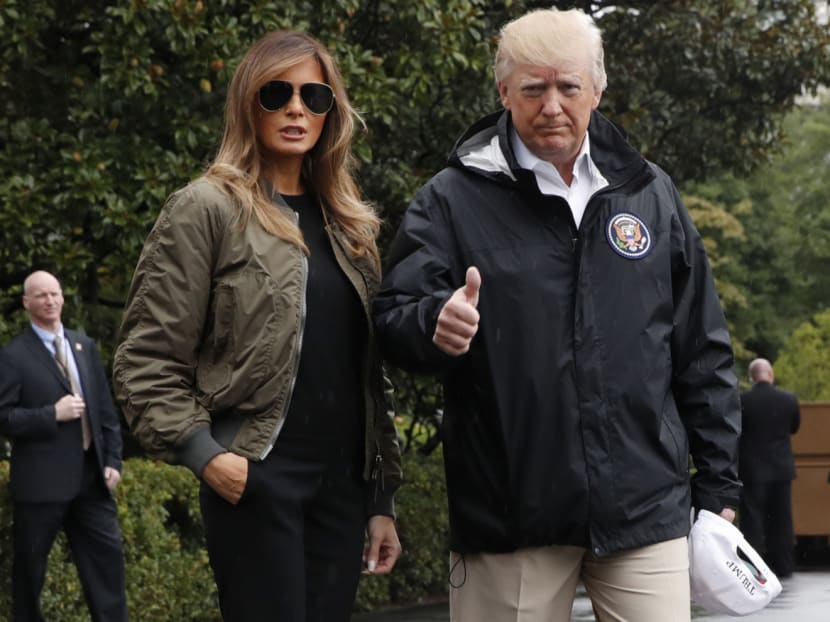Floods still rising as Trump visits Texas to assess storm damage
HOUSTON — United States President Donald Trump visited Texas yesterday to survey the response to devastating Tropical Storm Harvey, the first major natural disaster of his White House tenure, even as the lingering storm pushed floodwaters higher.

President Donald Trump, accompanied by First Lady Melania, giving a thumbs-up at the White House yesterday before they left for Texas to survey the response to Hurricane Harvey. Photo: AP
HOUSTON — United States President Donald Trump visited Texas yesterday to survey the response to devastating Tropical Storm Harvey, the first major natural disaster of his White House tenure, even as the lingering storm pushed floodwaters higher.
The slow-moving storm has brought catastrophic flooding to Texas, killed at least 10 people, led to mass evacuations and paralysed Houston, the fourth most-populous American city. Some 30,000 people were expected to seek emergency shelter as the flooding entered its fifth day.
Mr Trump arrived in Corpus Christi yesterday, near where Harvey came ashore last Friday as the most powerful hurricane to strike Texas in more than 50 years. The president also visited Texas capital Austin to meet state officials, receive briefings and tour the emergency operation centre, the White House said.
Much of the Houston area remained under water yesterday and dangerous rescues went on through the night as police, firefighters and National Guard troops in helicopters, boats and trucks pulled stranded residents from flooded homes.
Members of about 1,000 households remained to be rescued, Houston Fire Chief Samuel Pena told ABC’s Good Morning America.
“We keep getting wave after wave after wave of rain and so that’s not calming the situation,” Mr Pena said.
As stunned families surveyed destroyed homes and roads flooded or clogged with debris, Texas Governor Greg Abbott told Houstonians to brace for a long recovery.
“We need to recognise this is going to be a new and different normal for this entire region,” Mr Abbott said, warning against expecting anything resembling recovery any time soon, or a return to the way things were.
Forecasters have compared Harvey to Hurricane Katrina, which lay waste to New Orleans and killed 1,800 people in 2005. The administration of then-president George W Bush drew accusations that his response was slow and inadequate — criticism that dealt a serious blow to his presidency.
Some who fled the rising floodwaters found they had few options, as roads were washed out and emergency services overloaded.
Ms Emely Gonzalez, 21, said she took her wheelchair-bound mother to a hospital but was turned away because doctors determined her condition was not an emergency. Having left the woman’s oxygen tank at home, her friend Chris Pastor had to head back to the flooded home by kayak to retrieve it and had to swim back.
“It was just a very delicate situation,” Mr Pastor said. The group later made it safely to a hotel.
Before Harvey, the last Category 4 hurricane to make landfall in Texas was Carla in 1961. Its high winds and torrential rains destroyed about 1,900 homes and nearly 1,000 businesses, the National Weather Service said.
Among the most recent deaths from Harvey was a man who drowned on Monday night while trying to swim across flooded Houston-area roads, the Houston Chronicle quoted the Montgomery County Constable’s Office as saying.
Since coming ashore, Harvey has virtually stalled along the Texas coast, picking up warm water from the Gulf of Mexico and dumping torrential rain from San Antonio to Louisiana.
The Houston metro area has suffered some of the worst precipitation with certain areas expected to receive more than 120cm of rain in a week, more than it typically receives for a year. Harvey was expected to produce another 18 to 33cm of rain through tomorrow over parts of the upper Texas coast into south-western Louisiana, the National Weather Service said.
“These stationary bands of tropical rain are very hard to time, very hard to place and are very unpredictable,” said Mr Alek Krautmann, a weather service meteorologist in Louisiana.
Schools and office buildings were closed throughout the Houston metropolitan area, where 6.8 million people live. The Federal Emergency Management Agency director Brock Long estimated that 30,000 people would eventually be housed temporarily in shelters. Houston and Dallas have set up shelters in convention centres and Austin was preparing to house as many as 7,000 evacuees. More than 9,000 people packed into an overcrowded shelter in Houston, a Red Cross spokesman told CNN.
Hundreds of Houston-area roads were blocked by high water. The city’s two main airports were shut as the floods turned runways into ponds and more than a quarter million customers were without power as of yesterday. AGENCIES






